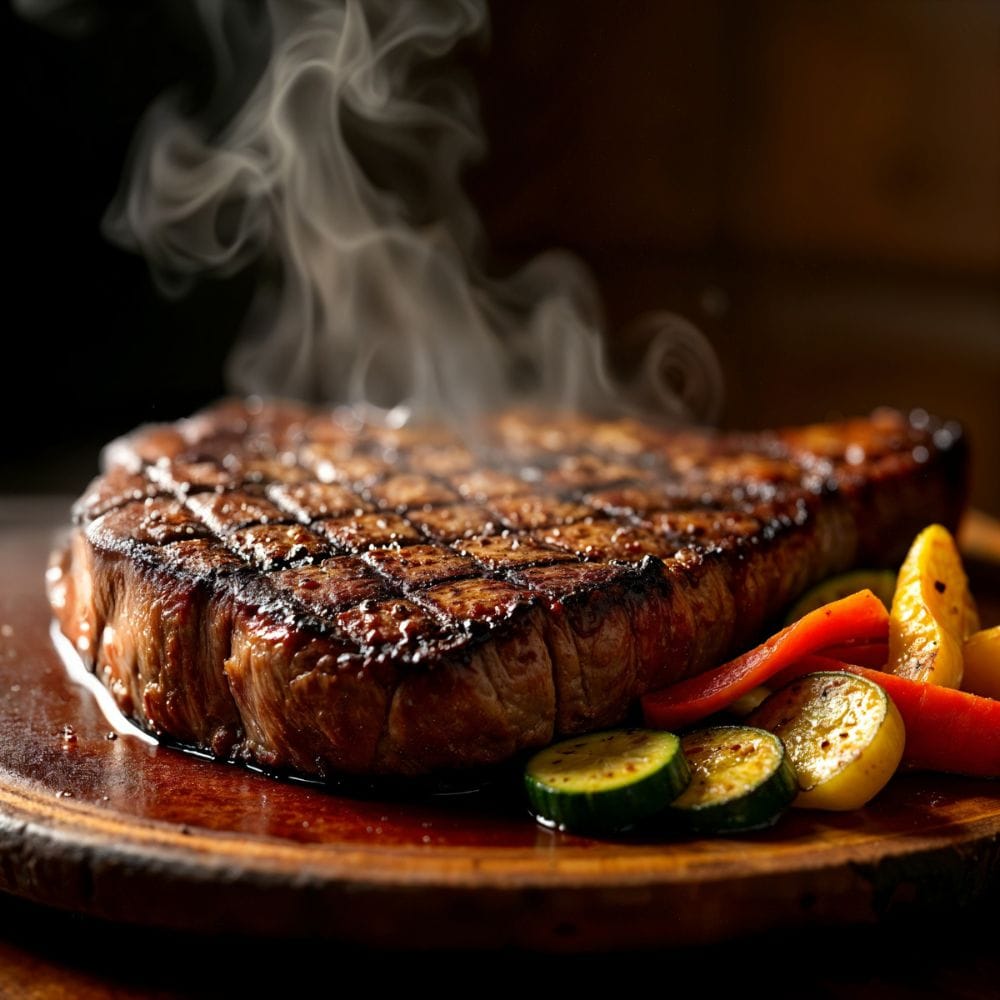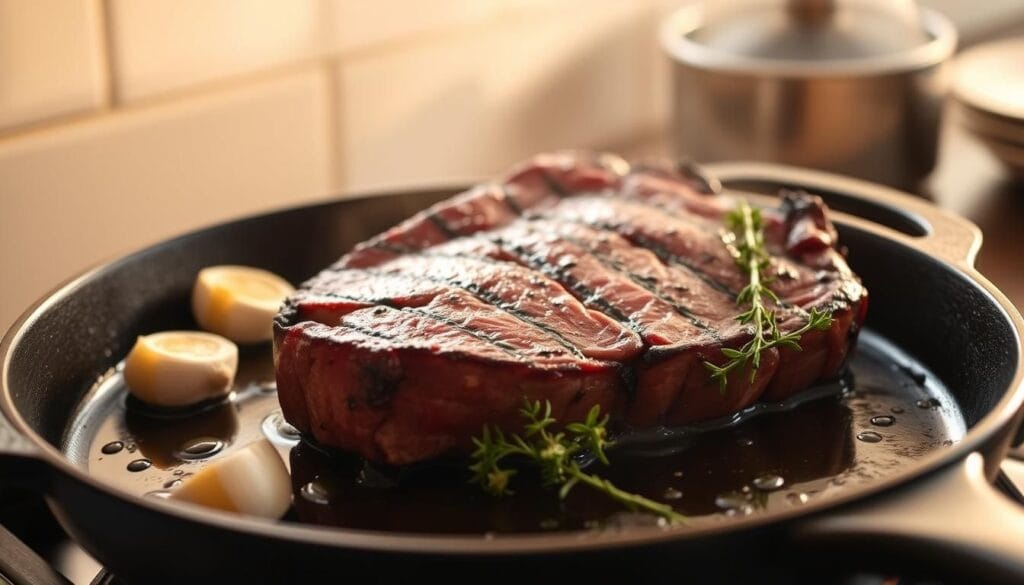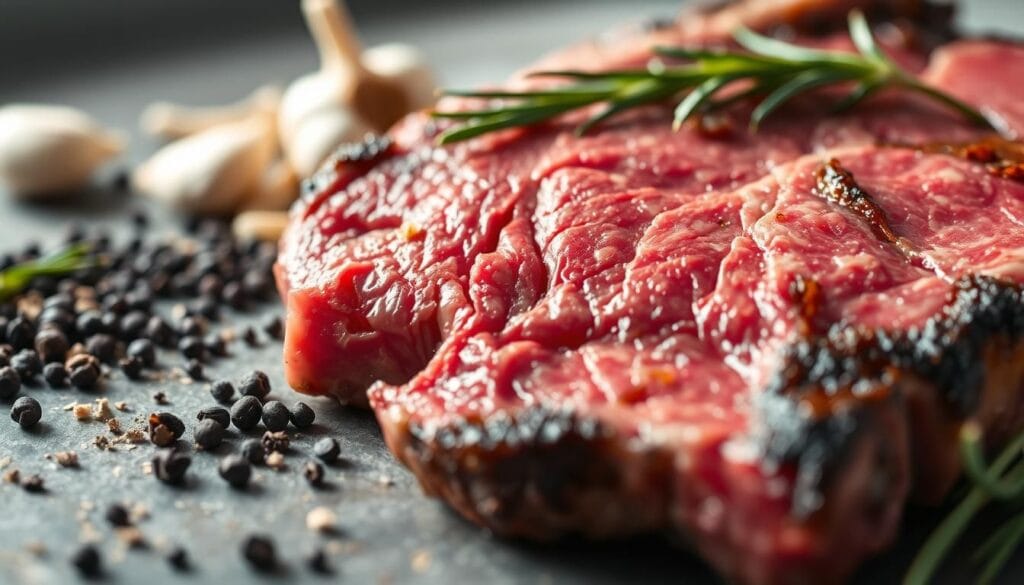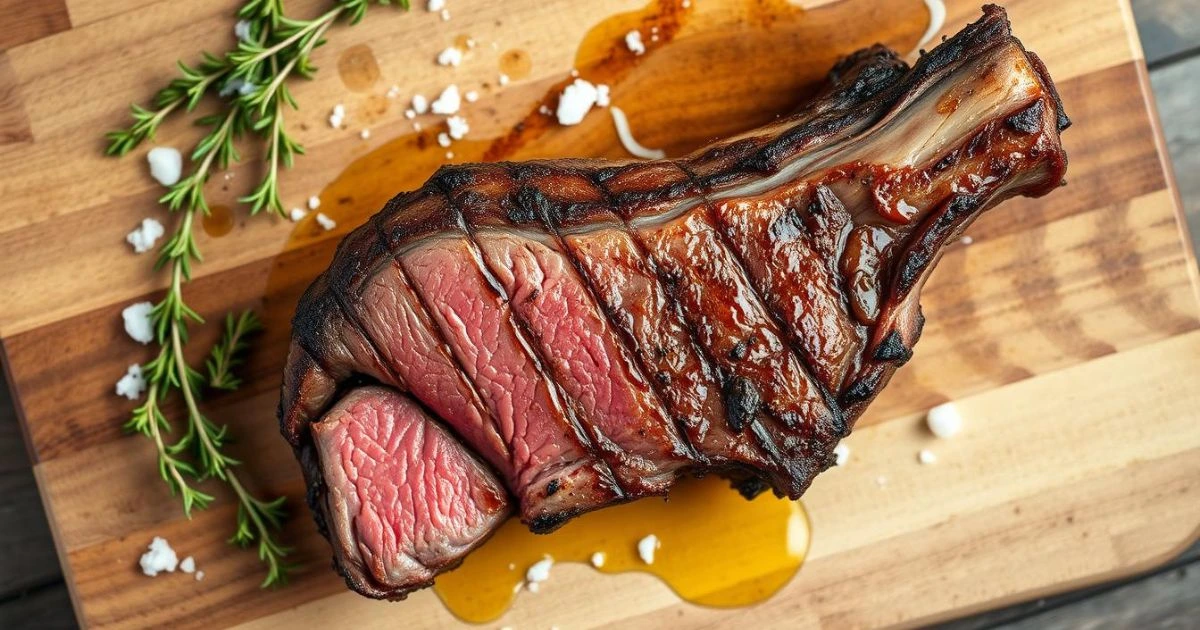Every food lover remembers that moment when they discover a culinary treasure hidden from mainstream attention. For me, that revelation came through hanger steak, a cut so rich in flavor yet surprisingly overlooked by many home cooks and casual diners.
What is hanger steak? Far from an ordinary beef cut, this prized meat represents a gourmet experience waiting to be explored. Nestled between the rib and loin of the cow, hanger steak offers an intensely beefy profile that transforms ordinary meals into extraordinary dining moments.
Chefs and butchers have long considered hanger steak their secret weapon. Its deep, robust flavor and tender texture make it a standout choice for those seeking something beyond standard steak cuts. Whether you’re a culinary enthusiast or simply someone who appreciates exceptional meat, this cut promises to elevate your cooking and dining experience.
In this guide, we’ll dive deep into the world of hanger steak, uncovering its origins, preparation techniques, and why it deserves a prominent place on your plate. Get ready to discover a steak that will revolutionize your approach to beef.
Table of Contents

Hanger Steak
Ingredients
Equipment
Method
- Trim the central membrane and excess fat.
- Pat the steak dry with paper towels.
- Let it rest at room temperature for 30–45 minutes.
- Season generously with salt and black pepper.
- For marinade: combine oil, acid, aromatics, and herbs. Coat steak and refrigerate for 2–4 hours (up to 8 max).
- Grilling: Preheat to 450–500°F. Grill steak 4–5 minutes per side for medium-rare.
- Pan-Searing: Heat cast-iron skillet until very hot. Add oil and sear 3–4 minutes per side.
- Rare: 120–125°F
- Medium-rare: 130–135°F (recommended)
- Medium: 140–145°F
- Let steak rest for 5–10 minutes.
- Slice thinly against the grain.
- Pair with sides like French fries (steak frites), roasted vegetables, mashed potatoes, or compound butter.
Notes
- Hanger steak is also known as Onglet in French cuisine.
- Always slice against the grain to maximize tenderness.
- Do not overcook, best served medium-rare.
- Leftovers can be used in tacos, salads, or stir-fries.
- Store cooked steak in the fridge for up to 3–4 days or freeze for up to 2 months.
Understanding the Butcher’s Best-Kept Secret
Hanger steak is a culinary treasure loved by chefs and meat lovers. It has a rich history and unique qualities that make it stand out. This makes it a favorite among those who know good meat.
Origins and Historical Significance
The hanger steak has a long history in butchery. It comes from the cow’s plate primal section, weighing about 1 to 1.5 pounds. French cuisine made it famous, turning it into a gourmet treat.
Why It’s Called the Butcher’s Steak
Butchers used to keep it for themselves, calling it “butcher’s steak”. They loved it for its great taste and tenderness. It was a secret favorite among chefs and butchers before it became popular.
Anatomical Location and Characteristics
So, what is hanger steak? It’s a muscle between the tenderloin and ribeye, near the diaphragm. This spot gives it amazing flavor and texture.
- Intense beef flavor
- Relatively tender texture
- Limited availability per animal
- Distinctive grain and marbling
The hanger steak’s unique spot in the cow ensures a strong flavor. Its rarity makes it a special treat for food lovers.
What Makes Hanger Steak Special

Hanger steak is a true gem in the culinary world. It wins the hearts of both food lovers and chefs. This special cut offers a unique taste experience with its bold beef flavor and distinct qualities.
The magic of hanger steak lies in its exceptional qualities:
- Robust beef-forward flavor that rivals premium cuts
- Tender texture with slightly coarser grain
- Affordable alternative to expensive steaks
- Versatile for multiple delicious hanger steak dishes
This cut is near the diaphragm, which makes it tender. Chefs love it for its rich marbling and deep flavor. It gives a taste experience like no other.
“Hanger steak is the butcher’s secret weapon for maximum flavor at a reasonable price point.”
Hanger steak is also great for your health. It’s full of protein and minerals. It offers a rich beef flavor that’s perfect for those who love meat and want a special culinary journey.
The Distinctive Flavor Profile of Hanger Steak
Hanger steak is a true gem in the culinary world. It has a flavor that really captures the essence of beef. This cut offers a taste experience unlike any other premium steak, making it a hit with meat lovers and chefs.

Comparison to Other Premium Cuts
Hanger steak is different from delicate cuts like filet mignon. It has a strong, intense beef flavor that meat lovers adore. Its flavor is unique compared to other premium cuts:
- More pronounced beef-forward taste
- Deeper, more complex flavor profile
- Richer meat intensity compared to milder cuts
Natural Marbling and Texture
The magic of hanger steak is its natural marbling. This fat weaves through the meat, making it tender and juicy. Chefs love how this marbling adds depth to the flavor in delicious hanger steak dishes.
Beef-Forward Taste Elements
Chefs say hanger steak’s flavor is a mix of mineral notes and rich umami. Its unique taste comes from being close to the diaphragm muscle. This makes its flavor more concentrated and intense than other beef cuts.
“Hanger steak represents the true spirit of beefy flavor – bold, unapologetic, and incredibly satisfying.”
Essential Preparation Techniques

Preparing hanger steak needs careful attention to get the best flavor and tenderness. The first steps in cooking hanger steak are key to a top-notch dish.
Before cooking, follow these essential preparation techniques for hanger steak recipes:
- Remove the central membrane: Most butchers will do this, but check carefully
- Trim excess fat, leaving a thin layer for flavor
- Bring the steak to room temperature before cooking
- Pat the meat dry with paper towels to ensure proper searing
Marinating can make your hanger steak unforgettable. The key is to balance marinades without overpowering the meat’s natural robust flavor. Choose simple marinades that enhance the steak’s taste.
| Preparation Step | Time Required | Purpose |
| Membrane Removal | 5-10 minutes | Improve tenderness |
| Fat Trimming | 3-5 minutes | Enhance cooking quality |
| Room Temperature Rest | 30-45 minutes | Ensure even cooking |
Seasoning is crucial in cooking hanger steak. Use kosher salt and freshly ground black pepper generously. This lets the meat’s natural flavors stand out. For bold hanger steak recipes, try herb rubs or light spice blends that complement the meat’s rich taste.
Mastering the Perfect Cooking Temperature
Cooking hanger steak to the right temperature is key to its amazing flavor and tenderness. It’s all about precision and paying close attention to internal temperature and resting techniques.

Grilling hanger steak to perfection means hitting the right doneness without losing its rich beef taste. Chefs suggest specific temperature ranges for the best results.
Temperature Guide for Different Doneness Levels
- Rare: 120-125°F (internal temperature)
- Medium Rare: 130-135°F (recommended for hanger steak)
- Medium: 140-145°F
- Well Done: 160°F and above (not recommended for hanger steak)
Using a Meat Thermometer Effectively
A good meat thermometer is crucial for cooking hanger steak. Stick it into the thickest part of the meat, avoiding fat or bone, for an accurate reading.
Resting Time Recommendations
After cooking, let your hanger steak rest for 5-10 minutes. This step is vital for a tender and flavorful steak. Patience during the resting period is key.
Pro Tip: The steak will continue cooking slightly during resting, so remove it from heat 5 degrees below your target temperature.
Grilling and Pan-Searing Methods

Learning to cook hanger steak involves two main methods: grilling and pan-searing. Each method has its own benefits for cooking this tasty beef cut.
Grilling Hanger Steak to Perfection
To grill hanger steak well, start by preparing it right. Heat your grill to 450-500°F. Dry the steak with paper towels for a great sear.
- Bring steak to room temperature before grilling
- Season generously with salt and black pepper
- Grill for 4-5 minutes per side for medium-rare
- Use tongs to flip, avoiding piercing the meat
Pan-Searing Technique
For cooking indoors, pan-searing is a top choice. A cast-iron skillet is ideal for indoor grilling, making a tasty crust.
- Heat cast-iron skillet until smoking hot
- Add a high smoke-point oil like avocado oil
- Sear steak for 3-4 minutes per side
- Let rest for 5-7 minutes before slicing
Pro tip: Always slice hanger steak against the grain to maximize tenderness and flavor.
The key to perfect hanger steak is high heat and minimal handling.
Creating the Ultimate Hanger Steak Marinade
Turning a good hanger steak into a great meal starts with the perfect marinade. The right mix of ingredients can boost the steak’s rich flavors. This makes your hanger steak recipes unforgettable.
Essential Marinade Ingredients
A top-notch hanger steak marinade needs a mix of key ingredients. Each one is important for tenderizing and adding flavor to the meat.
- Acid base: Vinegar or citrus juice to tenderize the meat
- Oil: Olive oil or neutral cooking oils to help distribute flavors
- Aromatics: Garlic, shallots, or fresh herbs for depth
- Seasonings: Salt, pepper, and additional spices
Timing and Technique Tips
Getting the hanger steak marinade right takes precision. The right marinating time can greatly affect taste and texture.
| Marinating Time | Flavor Intensity | Recommended Use |
| 10-30 minutes | Light | Delicate flavor enhancement |
| 2-4 hours | Medium | Balanced flavor penetration |
| 4-8 hours | Intense | Maximum flavor absorption |
Pro tip for your hanger steak marinade: Don’t marinate for more than 8 hours. Acid can break down the meat’s proteins, making it mushy. Always marinate in a non-reactive container and refrigerate for safety.
The secret to an incredible hanger steak is not just in the marinade, but in understanding how flavors interact with the meat’s natural characteristics.
Serving Suggestions and Accompaniments
Hanger steak is incredibly versatile. It can turn any meal into something special. It’s loved by both home cooks and professional chefs for its flavor.
Classic pairings bring out the best in hanger steak. Traditional recipes suggest:
- Crispy French fries (steak frites)
- Roasted seasonal vegetables
- Creamy mashed potatoes
- Compound herb butter
For something new, try these creative ways to serve hanger steak:
- Sliced thin for street-style tacos
- Chopped in vibrant salads
- Incorporated into spicy stir-fries
- Served over creamy polenta
| Cuisine Style | Recommended Accompaniment | Flavor Profile |
| American | Garlic mashed potatoes | Rich, comforting |
| Mexican | Cilantro-lime rice | Bright, zesty |
| Asian | Ginger-scallion noodles | Aromatic, complex |
Use leftover hanger steak for tasty next-day meals. Try it in sandwiches, salads, or stir-fries. This way, you won’t waste any of its delicious flavor.
Storage and Reheating Guidelines
Keeping hanger steak tasty means storing and reheating it right. This way, your premium cut stays safe and delicious for later.
Proper Storage Methods
After cooking your hanger steak, follow these essential storage guidelines:
- Cool the hanger steak to room temperature within 2 hours of cooking
- Store in an airtight container or sealed plastic wrap
- Refrigerate at 40°F or below
- Consume refrigerated hanger steak within 3-4 days
Best Reheating Practices
Reheating hanger steak needs care to keep its great taste and texture. Different ways can make it taste like new again.
| Reheating Method | Temperature | Time | Result |
| Oven | 275°F | 10-15 minutes | Gentle, even heating |
| Stovetop | Medium-low | 3-4 minutes | Quick, controlled warming |
| Microwave | 50% power | 30-45 seconds | Fastest, potential texture loss |
Freezing Instructions
Freezing is a great way to keep your hanger steak fresh longer. Here’s how to do it right:
- Wrap hanger steak tightly in plastic wrap
- Place in a freezer-safe container or vacuum-sealed bag
- Remove as much air as possible to prevent freezer burn
- Label with the date of freezing
- Store at 0°F for up to 2 months
When you’re ready to eat it, thaw the steak in the fridge overnight. Never refreeze meat that’s already been frozen to keep it safe and tasty.
Finding and Selecting Quality Hanger Steak
Finding a great hanger steak takes some knowledge and careful picking. This special cut might be harder to find than other beef, but with the right steps, you can get a tasty hanger steak. It will make your cooking much better.
When looking for hanger steak, check these main places:
- Local butcher shops
- Specialty meat markets
- High-end grocery stores
- Online meat retailers
- Farm-to-table providers
Knowing what hanger steak is helps you choose better. Look for these important signs of quality:
| Quality Indicator | What to Look For |
| Color | Deep red, consistent throughout |
| Marbling | Fine, even white fat distribution |
| Texture | Smooth, firm surface without blemishes |
| Source | Grass-fed or pasture-raised beef |
Tip for hanger steak lovers: Get to know your local butcher. They can share the best cuts, when they’re in season, and even save special cuts for you.
When buying, choose fresh, high-quality meat from trusted places. Feel free to ask about the beef’s background, how it was processed, and the best ways to cook it.
Conclusion
Hanger steak is a game-changer for both home cooks and professional chefs. It offers a perfect mix of flavor, tenderness, and price. This makes it stand out from other steak cuts.
Exploring hanger steak is more than just cooking. It’s about embracing a cut that’s been overlooked but now leads in modern cooking. Chefs in the U.S. are now using it in new and exciting ways.
To master hanger steak, you need patience, knowledge, and a love for trying new things. Whether you grill, pan-sear, or marinate it, the effort pays off. The secret is to cook it with confidence and respect its natural taste.
Hanger steak shows the beauty of finding hidden treasures in cooking. By trying this cut, home cooks can improve their skills, wow their guests, and have a memorable meal. It’s all about celebrating the art of cooking beef.
FAQ
What exactly is hanger steak?
Hanger steak is a flavorful cut from the cow’s plate section. It’s between the ribs and the tenderloin. Known for its intense flavor and tender texture, it’s called the “butcher’s steak.”
Why is hanger steak considered special?
It’s prized for its rich flavor and tender texture. Its marbling makes it taste better than many other cuts. Plus, it’s often more affordable than premium steaks.
How should I cook hanger steak for the best results?
Cook it by grilling or pan-searing to medium-rare or medium. Cook quickly over high heat. Let it rest for 5-10 minutes after cooking.
What are the best marinades for hanger steak?
Use marinades with acid, oil, and seasonings. Try Asian or Mediterranean flavors. But don’t over-marinate, as it can make the meat tough.
Where can I buy hanger steak?
You can find it at specialty butcher shops, farmers markets, and some high-end supermarkets. Online meat retailers also carry it. Ask your local butcher if they have it.
How should I store leftover hanger steak?
Store it in an airtight container in the fridge for 3-4 days. Reheat gently to keep it tender and flavorful.
Is hanger steak nutritious?
Yes, it’s packed with protein, iron, and B vitamins. It’s lean, making it a healthy beef option.
What’s the best way to slice hanger steak?
Slice it against the grain for tenderness. Cutting perpendicular to the fibers makes it easier to chew.
Can I freeze hanger steak?
Yes, you can freeze it. Wrap it tightly in freezer paper or vacuum-seal. It keeps for 3-4 months. Thaw in the fridge before cooking.
What are some classic dishes to make with hanger steak?
It’s great in steak frites, tacos, salads, stir-fries, and as a grilled steak. It’s a favorite in French and Latin American cooking.
There are no reviews yet. Be the first one to write one.

